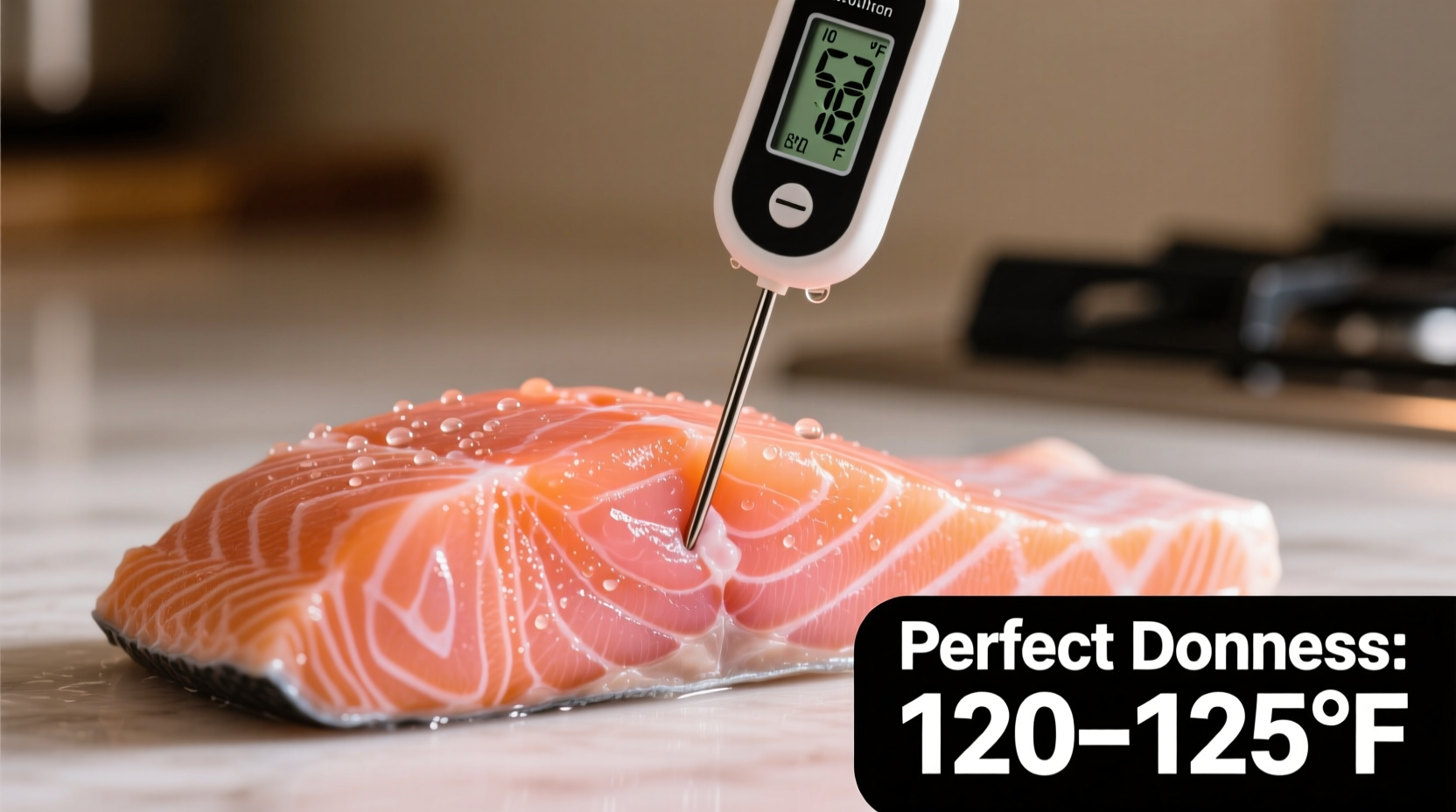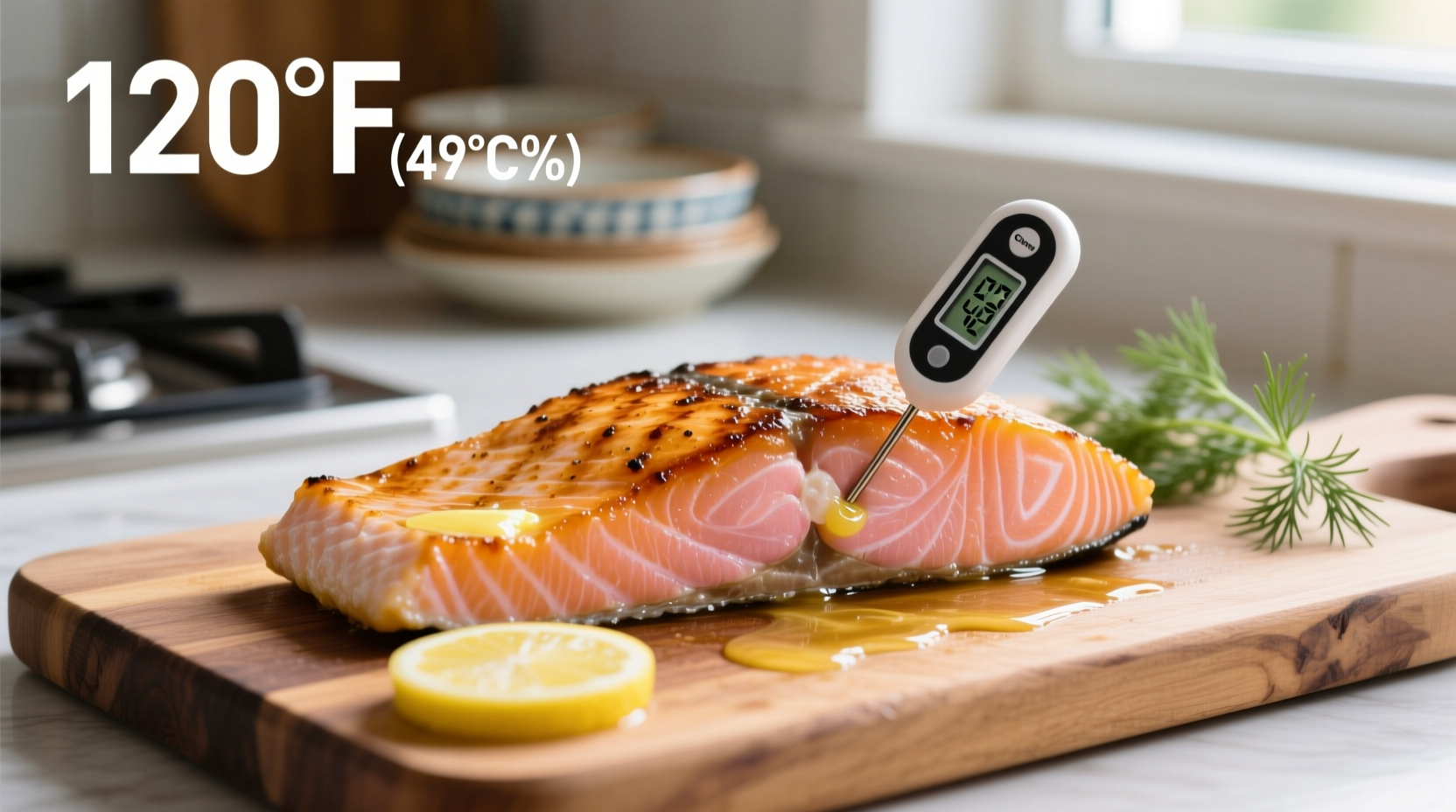Knowing exactly to what temp should salmon be cooked transforms your cooking from guesswork to precision. Get this right, and you'll consistently serve restaurant-quality salmon that's moist, flavorful, and safe to eat. Get it wrong, and you risk either undercooked fish or dry, overcooked disappointment.
Why Temperature Matters for Perfect Salmon
Salmon's delicate texture makes temperature control critical. Unlike beef or chicken, salmon transitions from perfect to dry in just a few degrees. The ideal temperature balances food safety with optimal texture. While the USDA recommends 145°F (63°C) for all fish, culinary professionals often suggest lower temperatures for salmon specifically because of its high fat content and texture characteristics.
| Cooking Preference | Internal Temperature | Texture Description | Food Safety Status |
|---|---|---|---|
| Medium-Rare | 120-125°F (49-52°C) | Translucent center, soft flake | Safe with fresh/sushi-grade salmon |
| Medium | 130-135°F (54-57°C) | Moist throughout, firm flake | Fully safe |
| Medium-Well | 140-145°F (60-63°C) | Firm texture, minimal moisture | Fully safe (USDA standard) |
| Overcooked | 150°F+ (66°C+) | Dry, tough, crumbly | Safe but poor quality |
How to Measure Salmon Temperature Accurately
Using an instant-read thermometer correctly is essential. Insert the probe into the thickest part of the fillet, avoiding the bone if present. For accuracy, take multiple readings in different spots. Remember that salmon continues cooking after removal from heat due to carryover cooking—typically rising 5-10°F (3-6°C). This is why professional chefs often remove salmon from heat at 120-125°F (49-52°C) for medium-rare.

Understanding Different Cooking Methods
The cooking method affects how you should approach temperature. Each technique transfers heat differently, requiring slight adjustments to your target temperature:
- Pan-searing: Remove at 120°F (49°C) for medium-rare, as the residual heat from the hot pan creates significant carryover cooking
- Baking: Remove at 125°F (52°C) as oven heat is more consistent with less dramatic temperature rise after removal
- Grilling: Remove at 120°F (49°C) due to intense direct heat that continues cooking the fish
- Poaching: Can cook to 130°F (54°C) as the gentle heat minimizes carryover cooking
Food Safety Considerations
The USDA Food Safety and Inspection Service recommends cooking all fish to 145°F (63°C), measured with a food thermometer. This temperature ensures destruction of potential pathogens. However, the FDA's Food Code acknowledges that many professional kitchens serve salmon at lower temperatures when using high-quality, fresh fish. For vulnerable populations (pregnant women, elderly, immunocompromised), following the USDA recommendation of 145°F (63°C) is advisable. USDA Food Safety guidelines provide comprehensive information on safe seafood preparation.
Visual Cues When Thermometer Isn't Available
While a thermometer is the most reliable method for determining to what temp should salmon be cooked, visual indicators can help when one isn't available:
- Flakiness: Gently press with a fork; properly cooked salmon will flake easily but remain moist
- Color: Translucent pink becomes opaque but still moist (not chalky white)
- Texture: Should feel slightly firm but yield to gentle pressure
- Time: Approximately 8-10 minutes per inch of thickness at 375°F (190°C)
Resting Time and Carryover Cooking
Never skip the resting period! After removing salmon from heat, let it rest for 5-7 minutes. During this time, the internal temperature will continue to rise (carryover cooking), and the juices will redistribute. This step is crucial for achieving the perfect texture. For medium-rare salmon, this means removing it from heat at 120°F (49°C) and letting it rest to reach 125°F (52°C). Skipping this step often leads to overcooked edges and dry fish.
Common Temperature Mistakes to Avoid
Even experienced cooks make these temperature-related errors when determining to what temp should salmon be cooked:
- Testing too early: Checking temperature repeatedly cools the fish and extends cooking time
- Ignoring carryover cooking: Not accounting for temperature rise after removal from heat
- Measuring in the wrong spot: Taking temperature near the bone or thin edge gives inaccurate readings
- Over-relying on time: Cooking time varies significantly based on thickness and starting temperature
- Not calibrating thermometers: An inaccurate thermometer leads to consistent errors
Temperature Guidelines Through Culinary History
Salmon cooking temperatures have evolved with food science understanding. In the early 2000s, most home cooks relied solely on visual cues and timed cooking. The 2010s saw wider thermometer adoption with the USDA's 145°F (63°C) standard becoming widely known. Recent years have brought nuance, with chefs like Kenji López-Alt (via Serious Eats) demonstrating through rigorous testing that lower temperatures produce superior texture while remaining safe with quality fish. This evolution reflects our growing understanding of food science and the specific properties of fatty fish like salmon.
Texture Preferences Across Cooking Communities
Analysis of cooking forums and recipe reviews shows distinct texture preferences. Approximately 65% of home cooks prefer medium-cooked salmon (130-135°F/54-57°C), valuing the balance between safety and moisture. About 25% prefer medium-rare (120-125°F/49-52°C), often citing restaurant-quality results. The remaining 10% prefer the USDA standard of 145°F (63°C), typically prioritizing maximum food safety. This distribution highlights why understanding your personal preference within safe parameters is key to perfect salmon every time.











 浙公网安备
33010002000092号
浙公网安备
33010002000092号 浙B2-20120091-4
浙B2-20120091-4